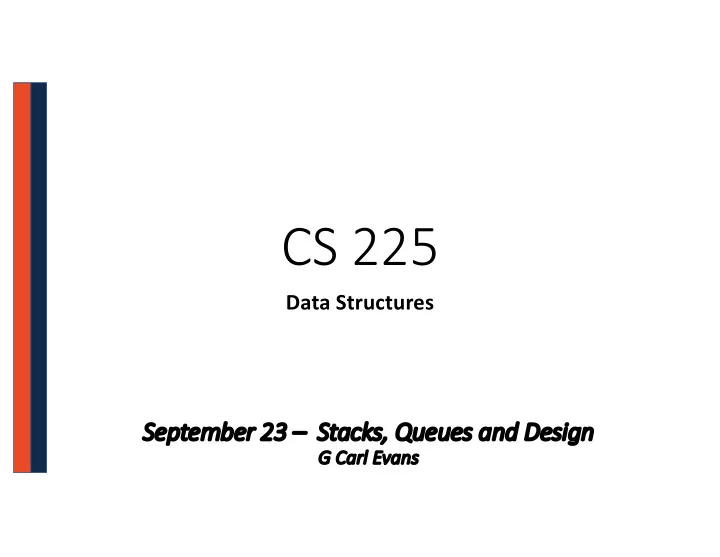

CS 225 Data Structures Se Septembe ber 23 23 – St Stac acks, Que ueue ues and and Design gn G G Carl Evans
CS 225 So Far… CS 225 So F r… List ADT • Linked Memory Implementation (“Linked List”) • O(1) insert/remove at front/back • O(1) insert/remove after a given element • O(n) lookup by index • Array Implementation (“Array List”) • O(1) insert/remove at front/back • O(n) insert/remove at any other location • O(1) lookup by index
Qu Queue ADT • [Order]: • [Implementation]: • [Runtime]:
St Stack ck A ADT • [Order]: • [Implementation]: • [Runtime]:
Queue.h What type of implementation is this Queue? 1 #pragma once 2 3 template <typename T> 4 class Queue { 5 public: 6 void enqueue(T e); 7 T dequeue(); How is the data stored on this Queue? 8 bool isEmpty(); 9 10 private: 11 T *items_; 12 unsigned capacity_; 13 unsigned size_; 14 }; 15 16 17 18 19 20 21 22
Queue.h What type of implementation is this Queue? 1 #pragma once 2 3 template <typename T> 4 class Queue { How is the data stored on this Queue? 5 public: 6 void enqueue(T e); Queue<int> q; 7 T dequeue(); 8 bool isEmpty(); q.enqueue(3); 9 q.enqueue(8); 10 private: q.enqueue(4); 11 T *items_; q.dequeue(); 12 unsigned capacity_; q.enqueue(7); 13 unsigned size_; q.dequeue(); 14 }; q.dequeue(); 15 q.enqueue(2); 16 q.enqueue(1); 17 18 q.enqueue(3); 19 q.enqueue(5); 20 q.dequeue(); 21 q.enqueue(9); 22
Queue.h Queue<char> q; 1 #pragma once … 2 m o n q.enqueue(m); 3 template <typename T> q.enqueue(o); 4 class Queue { 5 public: q.enqueue(n); 6 void enqueue(T e); … 7 T dequeue(); q.enqueue(d); 8 bool isEmpty(); q.enqueue(a); 9 q.enqueue(y); 10 private: q.enqueue(i); 11 T *items_; q.enqueue(s); 12 unsigned capacity_; q.dequeue(); 13 unsigned size_; q.enqueue(h); 14 }; 15 q.enqueue(a); 16 17 18 19 20 21 22
It Iter erators Suppose we want to look through every element in our data structure: Ø 8 2 5
Iterators encapsulated access to our data: Cur. Location Cur. Data Next Ø 8 2 5
It Iter erators Every class that implements an iterator has two pieces: 1. [Implementing Class]:
It Iter erators Every class that implements an iterator has two pieces: 2. [Implementing Class’ Iterator]: • Must have the base class std::iterator • Must implement operator* operator++ operator!=
stlList.cpp 1 #include <list> 2 #include <string> 3 #include <iostream> 4 5 struct Animal { 6 std::string name, food; 7 bool big; 8 Animal(std::string name = "blob", std::string food = "you", bool big = true) : 9 name(name), food(food), big(big) { /* nothing */ } 10 }; 11 12 int main() { 13 Animal g("giraffe", "leaves", true), p("penguin", "fish", false), b("bear"); 14 std::vector<Animal> zoo; 15 16 zoo.push_back(g); 17 zoo.push_back(p); // std::vector’s insertAtEnd 18 zoo.push_back(b); 19 20 for ( std::vector<Animal>::iterator it = zoo.begin(); it != zoo.end(); it++ ) { 21 std::cout << (*it).name << " " << (*it).food << std::endl; 22 } 23 24 return 0; 25 }
stlList.cpp 1 #include <list> 2 #include <string> 3 #include <iostream> 4 5 struct Animal { 6 std::string name, food; 7 bool big; 8 Animal(std::string name = "blob", std::string food = "you", bool big = true) : 9 name(name), food(food), big(big) { /* none */ } 10 }; 11 12 int main() { 13 Animal g("giraffe", "leaves", true), p("penguin", "fish", false), b("bear"); 14 std::vector<Animal> zoo; 15 16 zoo.push_back(g); 17 zoo.push_back(p); // std::vector’s insertAtEnd 18 zoo.push_back(b); 19 20 for ( const Animal & animal : zoo ) { 21 std::cout << animal.name << " " << animal.food << std::endl; 22 } 23 24 return 0; 25 }
Recommend
More recommend